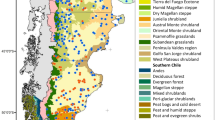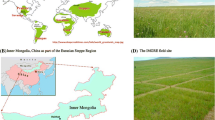Abstract
We studied indicators of rangeland health on benchmark sites with long, well documented records of protection from stress by domestic livestock or histories of environmental stress and vegetation change. We measured ecosystem properties (metrics) that were clearly linked to ecosystem processes. We focused on conservation of soil and water as key processes in healthy ecosystems, and on maintenance of biodiversity and productivity as important functions of healthy ecosystems. Measurements from which indicators of rangeland health were derived included: sizes of unvegetated patches, cover and species composition of perennial grasses, cover and species composition of shrubs and herbaceous perennials, soil slaking, and abundance and species composition of the bird fauna. Indicators that provided an interpretable range of values over the gradient from irreversibly degraded sites to healthy sites included: bare patch index, cover of long-lived grasses, palatability index, and weighted soil surface stability index. Indicators for which values above a threshold may serve as an indicator of rangeland health include: cover of plant species toxic to livestock, cover of exotic species, and cover of increaser species. Several other indicator metrics were judged not sensitive nor interpretable. Examples of application of rangeland health indicators to evaluate the success of various restoration efforts supported the contention that a suite of indicators are required to assess rangeland health. Bird species diversity and ant species diversity were not related to the status of the sample site and were judged inadequate as indicators of maintenance of biodiversity.
Similar content being viewed by others
References
Anable, M. E., M. P. McClaran, Ruyle, G. B. 1992. “Spread of introduced Lehmann lovegrass (Eragrostis lehmanniana Nees.) in southern Arizona, USA.” Biol. Cons. 61:181–188.
Andrew, M. H., Lange, R. T. 1986. “Development of a new piosphere in arid chenopod shrubland grazed by sheep. 2. Changes to the vegetation”. Australian J. Ecology 11: 411–424.
Bevan, K., Germann, P. 1982. “Macropores and water flow in soils.” Water Resources Research 18:1311–1325.
Bradford, D. F., Franson, S. E., Neale, A. C., Heggem, D. T., Miller, G. R., Canterbury, G. E. 1997. “Bird species assemblages as indicators of biological integrity in Great Basin rangeland.” Environ. Monitor. Assess. (In Press)
Buffington, L. C., Heibel, C. H. 1965. “Vegetation changes on a semi-desert grassland range from 1858 to 1963.” Ecol. Monogr. 35:139–164.
Canfield, R. H. 1941. “Application of the line interception method in sampling range vegetation.” J. Forestry 39: 388–394.
De Soyza, A. G., Whitford, W. G., Herrick, J. E. 1996. “Sensitivity testing of indicators of ecosystem health.” Ecosystem Health (In press).
Dick-Peddie, W. A. 1993. “New Mexico Vegetation, Past, Present and Future.” University of New Mexico Press, Albuquerque, N.M.
Elkins, N. Z., Sobal, G. V., Ward, T. J., Whitford, W. G. 1986. “The influence of subterranean termites on the hydrological characteristics of a Chihuahuan Desert ecosystem.” Oecologia 68:521–528.
Fisher, F. M., Freckman, D. W., Whitford, W. G. 1990. “Decomposition and soil nitrogen availability in Chihuahuan Desert field microcosms.” Soil Biol. Biochem. 22:241–249.
Fusco M., Holachek, J., Tebo, A., Daniel, A., Cardenas, M. 1995. “Grazing influence of watering point vegetation in the Chihuahuan Desert.” J. Range Mgmt. 48: 186–192.
Gardiner, J. L. 1951. “Vegetation of the creosotebush area of the Rio Grande valley in New Mexico.” Ecological Monographs 21:397–403.
Gibbens, R. P., Beck, R. F. 1988. “Changes in grass basal area and forb densities over a 64-year period on grassland types of the Jornada Experimental Range.” J. Range Mgmt. 41:186–192.
Gibbens, R. P., Beck, R. F., McNeely, R. P., Herbel, C. H. 1992. “Recent mesquite establishment in the northern Chihuahuan Desert.” J. Range Mgmt. 45:585–588.
Grover, H. D., Musick, H. B. 1990. “Shrubland encroachment in southern New Mexico, U. S. A.: An analysis of desertification processes in the American southwest.” Climatic Change 17:305–330.
Herbel, C. H., Ares, F., Bridges, J. 1958. “Hand-grubbing mesquite in the semidesert grassland.” J. Range Mgmt. 11: 267–270.
Herbel, C. H., Abernathy, G. H., Yarbrough, C. C., Gardner, D. K. 1973. “Rootplowing and seeding arid rangelands in the southwest.” J. Range Mgmt. 26: 193–197.
Herbel, C. H., Gould, W. L., Leifeste W. F., Gibbens, R. P. 1983. “Herbicide treatment and vegetation response to treatment of mesquites in southern New Mexico.” J. Range Mgmt. 36: 149–151.
Herbel, C. H., Morton H. L., Gibbens, R. P. 1985. “Controlling shrubs in the arid southwest with tebuthiuron.” J. Range Mgmt. 38: 391–394.
Herbel, C. H., Gibbens, R. P. 1996. “Post-drought vegetation dynamics on and rangelands in Southern New Mexico. New Mexico State Univ. Agric. Exper. Sta. Bull. 776, Las Cruces, NM.
Herrick, J. E., Whitford, W. G., deSoyza, A. G., Van Zee, J. 1995. “Soil and Vegetation Indicators for Assessment of Rangeland Ecological Condition.” (pp. 157–166) In: Celedonio, A. G., ed. North American Working on Monitoring for Ecological Assessment of Terrestrial and Aquatic Ecosystems. USDA Forest Service, Rocky Mountain Forest and Range Experiment Station. 305 p.
Martinez-Meza, E., Whitford, W. G. 1996. “Stemflow, throughfall and channelization of stemflow by roots in three Chihuahuan Desert shrubs.” J. Arid Environ. 32:271–287.
Naranjo, L. G., Raitt, R. J. 1993. “Breeding bird distribution in Chihuahuan Desert habitats.” Southwest. Nat. 38:43–51.
National Research Council. 1994. “Rangeland Health New Methods to Classify. Inventory, and Monitor Rangelands.” National Academy Press 180 p.
Rapport, D. J., Regier, H. A., Hutchinson, T. C. 1985. “Ecosystem behaviour under stress.” Am. Nat. 125:617–640.
Santos, P. F., Depree, E., Whitford, W. G. 1978. “Spatial distribution of litter and microarthropods in a Chihuahuan Desert ecosystem.” J. Arid Environ. 1:41–48.
Skidmore, E. L. 1986. “Wind erosion control.” Climatic Change 9:209–218.
Stephens, G., Whitford, W. G. 1993. “Responses of Bouteloua eriopoda to irrigation and nitrogen fertilization in a Chihuahuan Desert rassland.” J. Arid Environ. 24:415–421.
Stubbendieck, J., Hatch, S. L., Butterfield, C. H. 1993. North American Range Plants (4th ed.) University of Nebraska Press, Lincoln.
Tongway, D. J., Ludwig, J. A. 1997. “The conservation of water and nutrients within landscapes.” In. Ludwig, J., Tongway D., rendenberger D., Noble, J., Hodgkinson, K. (eds.) Landscape Ecology: Function and Management. CSIRO Publishing, Collingwood, Victoria.
Tongway, D. 1994, “Rangeland Soil Condition Assessment Manual.” CSIRO. Division of Wildlife and Ecology, Australia.
Westoby, M., Walker, B., Noy-Meir, I. 1989, “Opportunistic management for rangelands not at equilibrium.” J. Range Manage. 42:266–274.
Whitford, W. G., Ludwig, J. A., Noble, J. C. 1992. “The importance of subterranean termites in semi-arid ecosystems in south-eastern ustralia.” J. Arid Environ. 22:87–91.
Whitford, W. G. 1995. Desertification: Implications and limitations of the ecosystem health metaphor. In: Rapport, D. J., Gaudet, C. L., alow, P. (eds) Evaluating and Monitoring the Health of Large-Scale Ecosystems NATO ASI Series, Vol. 128. Springer-Verlag, Berlin pp.271–296.
Whitford, W. G., Herrick, J. E. 1996. “Maintaining soil processes for plant productivity and community dynamics.” In: West, N. E. (ed) Rangelands in a sustainable biosphere (vol. 2) Proceedings of the Fifth International Rangeland Congress. Society for Range Management, Denver, CO pp. 33–37.
Whitford, W. G., Van Zee, J., Nash, M. S., Smith, W. E., Herrick, J. E. 1997. “Ants as indicators of exposure to environmental stressors in North American desert grasslands.” Environ. Monitor Assess. In Press.
Wiens, J. A. 1973. “Pattern and process in grassland bird communities.” Ecol. Monogr. 43:237–270.
Zobeck, T. M. 1991. “Soil properties affecting wind erosion.” J. Soil Water Conserv. 46:112–118.
Author information
Authors and Affiliations
Rights and permissions
About this article
Cite this article
Whitford, W.G., De Soyza, A.G., Van Zee, J.W. et al. Vegetation, Soil, and Animal Indicators of Rangeland Health. Environ Monit Assess 51, 179–200 (1998). https://doi.org/10.1023/A:1005987219356
Issue Date:
DOI: https://doi.org/10.1023/A:1005987219356




